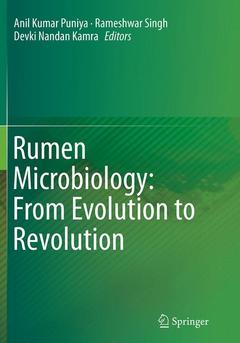Description
Rumen Microbiology: From Evolution to Revolution, 1st ed. 2015
Coordinators: Puniya Anil Kumar, Singh Rameshwar, Kamra Devki Nandan
Language: English
Subjects for Rumen Microbiology: From Evolution to Revolution:
Keywords
Bacteria; Fungi; Gene silencing; Microbial ecology; Protozoa
Publication date: 10-2016
Support: Print on demand
Publication date: 07-2015
379 p. · 17.8x25.4 cm · Hardback
Description
/li>Contents
/li>Biography
/li>Comment
/li>
This book offers an in-depth description of different groups of microbes (i.e. bacteria, protozoa, fungi and viruses) that exist in the rumen microbial community, and offers an overview of rumen microbiology, the rumen microbial ecosystem of domesticated ruminants, and rumen microbial diversity. It provides the latest concepts on rumen microbiology for scholars, researchers and teachers of animal and veterinary sciences. With this goal in mind, throughout the text we focus on specific areas related to the biology and complex interactions of the microbes in rumen, integrating significant key issues in each respective area. We also discuss rumen manipulation with plant secondary metabolites, microbial feed additives, utilization of organic acids, selective inhibition of harmful rumen microbes, and ?omics? approaches to manipulating rumen microbial functions. A section on the exploration and exploitation of rumen microbes addresses topics including the current state of knowledge on rumen metagenomics, rumen: an underutilized niche for industrially important enzymes and ruminal fermentations to produce fuels. We next turn our attention to commercial applications of rumen microbial enzymes and to the molecular characterization of euryarcheal communities within an anaerobic digester. A section on intestinal disorders and rumen microbes covers acidosis in cattle, urea/ ammonia metabolism in the rumen and nitrate/ nitrite toxicity in ruminant diets. Last, the future prospects of rumen microbiology are examined, based on the latest developments in this area. In summary, the book offers a highly systematic collection of essential content on rumen microbiology.
Part 1 - Overview of rumen and ruminants.- 1. Rumen Microbiology: An Overview.- 2. Rumen Microbial Ecosystem of Domesticated Ruminants.- 3. Domesticated Rare Animals (Yak, Mithun and Camel): Rumen Microbial Diversity.- 4. Wild Ruminants.- 5. Structure-and-function of a non-ruminant gut: a porcine model.- Part 2 - Rumen microbial diversity.- 6. Rumen bacteria.- 7. Rumen fungi.- 8. Rumen Protozoa.- 9. Ruminal viruses (Bacteriophages, Archaeaphages).- 10. Rumen Methanogens.- Part 3 - Rumen manipulation.- 11. Plant SecondaryMetabolites.- 12. Microbial feed additives.- 13. Utilization of organic acids to manipulate ruminal fermentation and improve ruminant productivity.- 14. Selective inhibition of harmful rumen microbes.- 15. Various ‘Omics’ approaches to understand and manipulate rumen microbial function.- Part 6 - Exploration and exploitation of rumen microbes.- 16. Rumen Metagenomics.- 17. Rumen: an underutilized niche for industrially important enzymes.- 18. Ruminal Fermentations toProduce Liquid and Gaseous Fuels.- 19. Commercial application of rumen microbial enzymes.- 20. Molecular characterization of Euryarcheal community within an anaerobic digester.- Part 5 - Intestinal disorders and rumen microbes.- 21. Acidosis in cattle.- 22. Urea/ ammonia metabolism in the rumen and toxicity in ruminants.- 23. Nitrate/ nitrite toxicity and possibilities of their use in ruminant diet.- Part 6 - Future prospects of rumen microbiology.- 24. The Revolution in Rumen Microbiology.
Dr. Anil Puniya, Principal Scientist, ICAR-National Dairy Research Institute, Karnal contributed significantly in rumen and dairy microbiology. He received PhD from NDRI, in 1994 during which he was awarded DAAD fellowship, Germany. He developed expertise in direct-fed microbial for enhanced animal productivity besides, probiotics for controlling lifestyle diseases.
He published over 120 research papers/ reviews/ book chapters of impact and 5 lab manuals. He acted as chairman, key-note/invited speaker in scientific events, nationally and internationally. He has been involved in 18 external funded and institutional projects as PI/ Co-PI and supervised a number of master and doctoral scholars. He remained Paper Coordinator of Food and Dairy Microbiology for E-contents (i.e. E-PG Pathshala) of UGC under National Mission on Education. He also developed E-course of Introductory Dairy Microbiology for BTech (DT) under NAIP of ICAR.
He was awarded DSE Grant to attend ‘International Conference of Tropical Veterinary Medicine’ in 1995 at Germany, and DST & CSIR funding to present a paper at ‘BioMicroWorld 2007’, Spain. He chaired sessions of ‘Food Microbiology’ during ‘BioMicroWorld 2009’, Portugal; and ‘Rumen Microbiology’ during ‘ANINUE-2012’, Thailand. Besides, he visited Aberystwyth University, UK, twice under ‘Exchange of Scientists Programme’ of INSA with Royal Society, London (2007), and as ‘DBT-CREST’ Awardee (2013). He visited Taiwan in 2010 during exposure visit of DST.
He is a recipient of Young Scientist Award in 1996 from Association of Microbiologist of India; Kautilya Gold Medal in 1998-99 from Nature Conservators; Best Young Scientist Award in 2004 from Eureka Forbes; K.K. Iya Award in 2006; Honorable Mention, in 2010 from American Society for Microbiology; and Certificate of Appreciation from ABRCMS, 2012-13 & 2014, USA. He is a member of International Scientific Advisory Board of Formatex Research Centre, Spain.
He underwent trai

